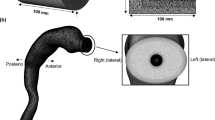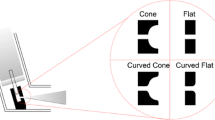Purpose
This study was conducted to identify the device factors influencing spray pattern and particle size to gain a more complete understanding of spray plume measurements.
Methods
A statistically designed experiment was used to investigate the influence of three actuator features (orifice diameter, expansion chamber depth, and orifice length) on spray pattern and particle size profiles. Custom-built actuators were manufactured and analyzed with laser light sheet illumination methods for spray patterns and laser diffraction for particle size analysis.
Results
In addition to orifice size, spray patterns were significantly influenced by the actuator orifice length and sump depth. Particle size analysis of the plumes generated from actuators used in these studies showed that all actuator features (orifice size, length, and sump depth) were significant factors influencing particle size.
Conclusions
The performance of propellant-based metered dose inhaler aerosols seems to be significantly related to sump depth and orifice length, in addition to orifice size. Rational design of propellant-based metered dose inhalers should therefore consider these variables in addition to formulation strategies and simply modifying orifice diameter.





Similar content being viewed by others
References
FDA, Guidance for industry metered dose inhaler (MDI) and dry powder inhaler (DPI) drug products, CDERGUID|2180dft.wpd, Nov 1998, http://www.fda.gov/cder/guidance/2180dft.pdf. 1998.
ITFG/IPAC-RS Collaboration, C.T.a.M.T.T. Recommendations for tests and methods. A response to the FDA draft guidance for industry. 2001 [cited; Available from: http://www.ipacrs.com/PDFs/Recommendations_for.PDF.
A. H Lefebvre (1989) Atomization and sprays N. Chigier (Eds) Combustion: An International Series Taylor and Francis New York
H. D. C. Smyth et al. Spray pattern analysis for metered dose inhalers I: orifice size, particle size, and droplet motion correlations. Drug Dev. Ind. Pharm., in press.
H. D. C. Smyth A. J. Hickey (2003) ArticleTitleMultimodal particle size distributions emitted from HFA 134a solution pressurized metered dose inhalers AAPS PharmSciTech 4 IssueID3 38 Occurrence Handle10.1208/pt040338
D. Ganderton et al. (2003) ArticleTitleThe formulation and evaluation of a CFC-free budesonide pressurised metered dose inhaler Respir. Med. 97 IssueIDSuppl D S4–S9 Occurrence Handle14753246 Occurrence Handle10.1016/j.rmed.2003.10.003
J. Berry et al. (2003) ArticleTitleInfluence of the metering chamber volume and actuator design on the aerodynamic particle size of a metered dose inhaler Drug Dev. Ind. Pharm. 29 IssueID8 865–876 Occurrence Handle14570307 Occurrence Handle1:CAS:528:DC%2BD3sXntFamtLc%3D Occurrence Handle10.1081/DDC-120024182
D. Ganderton et al. (2002) ArticleTitleModulite: a means of designing the aerosols generated by pressurized metered dose inhalers Respir. Med. 96 IssueIDSuppl D S3–S8 Occurrence Handle12201079 Occurrence Handle10.1016/S0954-6111(02)80018-X
H. L. Ashworth et al. (1991) ArticleTitleDelivery of propellant soluble drug from a metered dose inhaler Thorax 46 IssueID4 245–247 Occurrence Handle2038731 Occurrence Handle1:STN:280:DyaK3M3kslSjtA%3D%3D Occurrence Handle10.1136/thx.46.4.245
G. Brambilla et al. (1999) ArticleTitleModulation of aerosol clouds produced by pressurized inhalation aerosols Int. J. Pharm. 186 IssueID1 53–61 Occurrence Handle10469923 Occurrence Handle1:CAS:528:DyaK1MXlsFOrurw%3D Occurrence Handle10.1016/S0378-5173(99)00137-4
A. R. Clark (1992) ArticleTitlePhysics of aerosol formation by MDIs—limitations of the current approach J. Biopharm. Sci. 3 IssueID1–2 69–76 Occurrence Handle1:CAS:528:DyaK38XltlOms74%3D
D. Lewis et al. Effects of actuator orifice diameter on beclomethasone dipropionate delivery from a pMDI HFA solution formulation, in RDD VI. 1:363–364 (1998).
G. P. Polli et al. (1969) ArticleTitleInfluence of formulation on aerosol particle size J. Pharm. Sci. 58 484–486 Occurrence Handle5787451 Occurrence Handle1:CAS:528:DyaF1MXktlegurk%3D
J. A. Ranucci, D. Cooper, and K. Sethachutkul. Effect of actuator design on metered-dose inhaler plume-particle size. Pharm. Technol. 16:84, 86, 88, 90–92 (1992).
H. D. C. Smyth (2003) ArticleTitleThe influence of formulation variables on the performance of alternative propellant-driven metered dose inhalers Adv. Drug Deliv. Rev. 55 IssueID7 807–828 Occurrence Handle12842602 Occurrence Handle1:CAS:528:DC%2BD3sXkvFeksbY%3D Occurrence Handle10.1016/S0169-409X(03)00079-6
C. A. Dunbar A. P. Watkins J. F. Miller (1997) ArticleTitleAn experimental investigation of the spray issued from a pMDI using laser diagnostic techniques J. Aerosol Med. 10 IssueID4 351–368 Occurrence Handle10175964 Occurrence Handle1:STN:280:DyaK1c%2FpslKnug%3D%3D
A. R. Clark (1991) Metered Atomization for Respiratory Drug Delivery Loughborough University of Technology UK
A. R. Clark (1996) ArticleTitleMDIs: physics of aerosol formation J. Aerosol Med. 9 IssueIDS1 S19–S26 Occurrence Handle10160054 Occurrence Handle10.1089/jam.1996.9.Suppl_1.S-19
C. A. Dunbar (1998) ArticleTitleAtomization mechanisms of the pressurized metered dose inhaler Part. Sci. Technol. 15 IssueID3–4 253–271
C. A. Dunbar A. P. Watkins J. F. Miller (1997) ArticleTitleApplication of laser diagnostic techniques to characterize the spray issued from a pMDI Proc. Int. Conf. Liq. At. Spray Syst. 1 IssueID7th 641–648 Occurrence Handle1:CAS:528:DyaK1MXhtFei
C. A. Dunbar A. P. Watkins J. F. Miller (1997) ArticleTitleCharacterization of the pMDI spray using numerical methods Proc. Int. Conf. Liq. At. Spray Syst. 2 IssueID7th 876–883 Occurrence Handle1:CAS:528:DyaK1MXpslI%3D
C. A. Dunbar A. P. Watkins J. F. Miller (1997) ArticleTitleTheoretical investigation of the spray from a pressurized metered-dose inhaler At. Sprays 7 IssueID4 417–436 Occurrence Handle1:CAS:528:DyaK1cXjtVSisbg%3D
W. H. Finlay (2001) The Mechanics of Inhaled Pharmaceutical Aerosols Academic Press London
Acknowledgments
The authors would like to thank Bespak Inc., Apex, North Carolina, for financial support for this work. In addition, we would like to thank Helen Newell for providing advice in the preparation of the manuscript.
Author information
Authors and Affiliations
Corresponding author
Rights and permissions
About this article
Cite this article
Smyth, H., Brace, G., Barbour, T. et al. Spray Pattern Analysis for Metered Dose Inhalers: Effect of Actuator Design. Pharm Res 23, 1591–1596 (2006). https://doi.org/10.1007/s11095-006-0280-z
Received:
Accepted:
Published:
Issue Date:
DOI: https://doi.org/10.1007/s11095-006-0280-z




